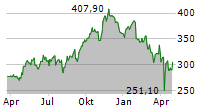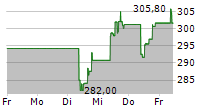
NORTHAMPTON, MA / ACCESSWIRE / January 9, 2025 / Trane Technologies
Integrating advanced AI technology in HVAC systems is supercharging what's possible for reducing built environment emissions.

This article is authored by Riaz Raihan, Senior Vice President and Chief Digital Officer, Trane Technologies.
From big city skyscrapers and suburban shopping centers to small town storefronts and rural manufacturing facilities, commercial buildings vary widely - but there's one thing they all have in common. They use, and can waste, a lot of energy.
Unpredictable factors such as weather conditions and building occupancy levels have long led to a building's energy inefficiencies. Today, new technologies, including thermal management systems and thermal storage, waste heat recovery and all-electric heat pumps, are increasing buildings' energy efficiency levels while drastically shrinking their carbon footprint.
But in a continually warming world, demand for cooling is only increasing. As such, HVAC systems play a crucial role in our shared vision for a net-zero future - and their integration of advanced AI technology is supercharging what's possible for reducing built environment emissions.
Ironically, the keys to a not-so-distant future where commercial buildings operate more efficiently, waste less energy and reduce emissions can be found in one of the largest and fastest-growing consumers of energy: data centers.
Demand-Side Energy Management
According to the U.S. Department of Energy, data centers consume anywhere from 10 to 50 times more energy than a typical commercial building and account for about 2% of total U.S. electricity consumption. As a result of AI, demand for energy is expected to nearly double or even triple in the next few years.
Everyone is talking about the supply side of this equation. How much power will need to be generated to meet that increased demand, how to add more renewable energy sources and how can we green the grid?
As a global climate innovator and leading provider of HVAC systems, we are focused on the generated power that's being wasted - what we call demand-side management. We've done hundreds of thousands of energy audits in buildings and have found that most operate about 30% inefficiently.
Do the math. Data centers today use just 2% of our electricity supply, yet approximately 30% of the energy deployed to buildings is being wasted.
Can you imagine how much energy we could save if we solved that problem? If we could make buildings and their assets perform the way they were designed to, while improving wasted energy and overall consumption?
The great news is we can, and we are.
By connecting a building's assets, using technology like digital twins and leveraging an experienced and vast service capability, we can keep those assets operating at their original level of performance - basically reversing the aging process. This helps our customers lower both their carbon footprint and electric bill, what our company views as tangible "green for green" action.
And, by leveraging AI and real-time data management, sophisticated controls and building automation systems and continuous commissioning - we are advancing innovative digitization technologies that are enabling even further energy and cost savings.
So, rather than focusing on how AI is using more and more energy, we need a mindset shift toward how AI can help us dramatically reduce energy demand and emissions.
While it's easy to get lost in the numbers, the data tells a simple, but compelling, story: We can have a much greater impact by addressing energy waste and reducing energy demand - with AI serving as a major leverage point in our ability to do so successfully.
Purpose-Built AI For HVAC
Investing in purpose-built AI-for-HVAC is centered around reducing demand-side energy consumption. Of course, developing highly efficient thermal management systems that communicate with building controls to optimize the equipment and manage overall energy demand based on data is only one part of the solution.
We continuously innovate and enhance our products to operate more efficiently and lower their energy use. For many years, we've also used AI and structured data, such as sensor-based indoor temperature readings, to help optimize energy consumption and enable predictive maintenance. Now, we're adding unstructured data - think weather patterns, building occupancy levels and pollution conditions - to drive even more efficiency.
Both structured and unstructured data can help reveal actionable patterns and correlations that were not previously recognizable. HVAC systems must become smarter, learning how to respond and react in real time to changing conditions, including energy pricing fluctuations. These insights can help improve decision-making, optimize performance and advance innovation.
Overcoming A Few Challenges
While the benefits of AI-driven HVAC systems are substantial, implementing these solutions is not without challenge.
One common barrier to adoption is the perception that major investment is required. While initial costs may be incurred depending on factors such as building size, system complexity and age, or data source availability, AI solutions can help enable significant, long-term energy savings and increased efficiency - often resulting in paybacks of only one to three years, based on my experience.
Collecting and managing vast amounts of data from various sensors and sources also poses challenges in terms of accuracy, security and privacy. Ensuring that the data used by AI systems is reliable and protected is crucial for the successful implementation and operation of these technologies.
The Real Value
For HVAC systems, the truest value of its technologies is the energy that's saved, which provides a direct, immediate and positive impact on a building's carbon footprint while also delivering lower costs. And AI technology is proving itself as a catalyst for HVAC systems to not only reduce energy waste and lower energy consumption but also reduce emissions.
Collectively, we need fresh thinking on the real value of AI. We must rethink how it can help us dramatically reduce energy demand, and emissions. This could be a win for the planet, and for business, too.
This article was originally published at Forbes.
View additional multimedia and more ESG storytelling from Trane Technologies on 3blmedia.com.
Contact Info:
Spokesperson: Trane Technologies
Website: https://www.3blmedia.com/profiles/trane-technologies
Email: info@3blmedia.com
SOURCE: Trane Technologies
View the original press release on accesswire.com


